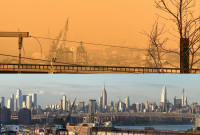Support strong Canadian climate journalism for 2025
On Monday, Lisa Spinney-Hutton arrived at her fourth home in under two weeks. She and her family have bounced from hotel to hotel, a cabin and an Airbnb after a wildfire forced them to evacuate their home on the outskirts of Halifax. They are still waiting to return.
The fire happened fast, she said. It started down the block from her house, and 10 minutes later, she stood outside watching grey and black smoke pour into the blue sky. She shot a video on her phone.
Minutes later, a neighbour told her firefighters were having trouble getting enough water from the dry hydrant, a non-pressurized system that takes water from a nearby water source, such as a pond.
“‘They can't get enough water,’ he said it like a whole bunch of times: ‘I just keep hearing them say, we can't get enough water from that dry hydrant,’” she said.
Minutes later, RCMP were running up and down the street telling people to get out.
Spinney-Hutton, her husband and her daughter went to Boston Pizza “because I didn't know what to do. I'm like, I don't know where we're supposed to go... Who are we supposed to talk to? What's going on? And no one else knew either.”
The fire forced more than 16,000 people from their homes in Hammonds Plains, Upper Tantallon and Pockwock, which are suburban communities about 25 kilometres away from Halifax. It destroyed about 200 buildings, including 151 homes.
While the fire in Spinney-Hutton’s community is considered under control, a wildfire in Shelburne County, about 240 kilometres west of Halifax, is still at 23,525 hectares: the largest in the province’s recorded history. The area is rural: 60 homes and 150 structures have been destroyed.
Since May 28, when Spinney-Hutton was evacuated, some things have become more clear. She said she is lucky because her home is still standing, because her family had places to stay. Also clear is that things need to change moving forward. Her neighbourhood was not built with wildfires in mind, and Canada is on track to have more intense and long wildfire seasons due to climate change.
Suburbs — like where Spinney-Hutton lives — are part of the “wildland-urban interface,” where buildings meet undeveloped swaths of land and forests. The areas are more vulnerable to fires, particularly when a high density of flammable trees and other vegetation are close to structures.
The relationship between those areas and wildfires has long been talked about in California, which now has around 5.1 million homes in the wildland-urban interface. There is proposed legislation in the state to curb housing development in areas that are prone to flood or fire.
Nothing like that is on the table for Nova Scotia, which is still actively fighting unprecedented wildfires, but conversations are bubbling up about how to protect homes and people who live in the wildland-urban interface.
As reported by the Halifax Examiner, government officials have known about these risks. In 2016, a map created by a fire prevention officer with the Department of Natural Resources marked the place where this fire started as “extreme” in terms of fire risk.

Now, following the fire, municipal officials are discussing the need for a second exit constructed in Spinney-Hutton’s Upper Tantallon neighbourhood.
As of now, “If you look at a map, you go in, and that's it. You have to go out the same way,” explained Spinney-Hutton, who said it’s something residents have long been nervous about.
Her community has been active in talking about fire preparedness, Spinney-Hutton adds. They had a fire-preparedness group where they recommended not leaving mulch in front of houses, for example. FireSmart Canada recommends similar protections, such as keeping gutters and roofs clean, cutting grass and weeds short and adding non-combustible screens to dryer vents to keep embers from entering.
It’s a lot to take in for Spinney-Hutton: that fires are increasing and that areas like where she lives are especially vulnerable. She moved from an apartment in the city around a decade ago in hopes of living somewhere with outdoor space: a yard for her kid to play in.
Now, she is gearing up to return to a charred neighbourhood, and is thinking about all the ways she needs to protect her home from future fires.
“But there's an endpoint for us,” she said. “I really feel super awful. My heart goes out to the families who've lost things that are irreplaceable.”






Comments